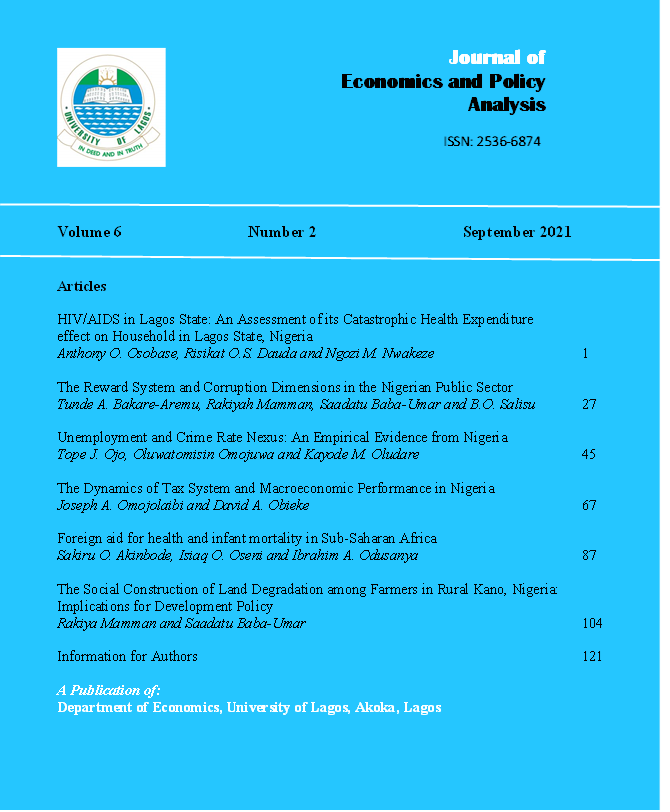Unemployment and Crime Rate Nexus: An Empirical Evidence from Nigeria
Abstract
Unemployment undoubtedly results in inadequate necessities in the immediate family, which cascades into poverty in the community and the economy as a whole. To this end, so many Nigerians have lost trust in the government. Therefore, Nigeria's high crime rate has ultimately been caused by the country's high unemployment rate. The purpose of this study is to ascertain how unemployment has affected Nigeria's crime rate spanning from 1990 to 2020. The study used secondary data time series sourced from the World Development Indicator. The study used the Augmented Dickey Fuller test to show variable stationarity, the ARDL Bound test was equally used to assess the long run nexus between the variables, and the Autoregressive Distributed Lag Model (ARDL) was adopted as an estimating technique to analysis the data of the study. The outcome results reveals that in Nigeria, a high percentage of unemployment induced a high rate of crime, with a 1% rise in unemployment resulting in a 0.0830 increase in crime rate in Nigeria. To this end, the study concludes with the following policy recommendations: that government should endeavour to create jobs in order to reduce unemployment, and also government should create enabling environment in which people are encouraged to learn hand work, ready to become an entrepreneurs on their own and the like. More so, government should make sure whosoever proven guilty of a crime should face decisive penalties that commensurate the offence.
References
Adenuga, F.A., & Nor Azam, A.R. (2020). Effects of ethnic diversity and poverty on crime rate in Nigeria. Journal of Social Science and Humanities, 5(2), 1-19.
Akan, K.A., Egbo, K.A., & Owoseni, J. S. (2022). An assessment of the link between youth unemployment and crime in Obudu local government area of cross River State, Nigeria: Fixing the hinges. International Journal of Scientific and Management Research, 5(4), 175-190.
Alabi, T. (2014). Youths’ unemployment and crime control: An analysis of Nigerian experience. European Scientific Journal, 10(2), 301-312. Alemika, E.E. (2014). Crime and public safety in Nigeria. Cleen Foundation, Leiden University Catalogue.1–205. http://new.cleen.org/crime%20and%20public%20safety%20in%20Nigeria.pd
Anthony, A.A. (2013). Youths’ unemployment and crime in Nigeria: A nexus and implications for national development. International journal of Sociology and Anthropology, 5(8), 350-357.
Ayhan, F., & Bursa, N. (2019). Unemployment and crime nexus in European union countries: A panel data analysis. Yönetim Bilimleri Dergisi, 17(34), 465-484.
Deborah, E. (2020). Unemployment and insecurity in Rivers State. International Journal of Innovative Legal & Political Studies, 8(3), 74-87.
Ebobo U.C., & Akujobi A.T. (2022). The nexus among unemployment, poverty and crime in contemporary Nigeria. Reality of Politics, (19), 132-148.
Fajnzylber, P., Lederman, D., & Loayza, N. (2002). Inequality and violent crime. The journal of Law and Economics, 45(1), 1-39.
Garba, M.G., Ahmed B.M., & Sunday E. (2019). Violent crime and unemployment in Nigeria: An ARDL bound test cointegration. Journal Economic Info, 6(4), 21-24.
Gillani, S.Y.M., Rehman, H.U., & Gill, A.R. (2009). Unemployment, poverty, inflation and crime nexus: Cointegration and causality analysis of Pakistan. Pakistan Economic and Social Review, 79-98.
Godwin, A.U., Eucharia N.N., & Francis A.U. (2011). Youth unemployment and its consequences in Calabar metropolis: Need for government intervention. Global Journal of Social Sciences, 10(1&2), 75 – 82.
Janko, Z., & Popli, G. (2015). Examining the link between crime and unemployment: A time-series analysis for Canada. Applied Economics, 47 (37). 4007-4019.
Kimberley, H. (2019). Analyse the relationship between unemployment and crime. EC831-6-FY Project in Economics, University of Essex.
Munir, S., & Asghar, N. (2017). An analysis of the interrelationship among crime, misery index and institutional quality: A case study of Pakistan. Journal of political Studies, 24(1), 383-406.
National Bureau of Statistics, (2019). Poverty and inequality in Nigeria: Executive Summary. National Bureau of Statistics, (2018). Crime statistics: Reported offences by type and state. Annual Report. Research and Publication Unit Headquarters Abuja.
National Bureau of Statistics, (2017). Crime statistics. Nigerian Prisons Report. Ndubuisi, O.E. An Assessment of the Unemployment and Crime Nexus in Lagos State during the Covid-19 Period (2019-2021).
Nwigbo, T., & Imoh-Ita, I. (2016). Youth unemployment and crime rate in the Niger Delta: A comparative analysis of its intensity in Akwa Ibom, Bayelsa and Rivers State. Journal of Humanities and Social Science, 21(2), 07-11.
Omoniyi, M.B.I. (2016). Unemployment and underemployment as indices of Nigerian youths’ mental health and the place of agricultural revolution as a panacea: Implications for counselling. Journal of Education and Practice, 7(10), 80-88. Omotor, D.G., & Orubu, C.O. (2012). Searching for environmental Kuznets curve of some basics in Africa. Department of Economics, Delta State University, Abraka, Nigeria.
Sanam, M.N.A., & Hafeez, U.R. (2017). An analysis of the international among crime, misery index and institutional quality. Journal of Political Studies, 24(1), 170-182.
Skogh, G. (1973). A note on Gary Becker's crime and punishment: An economic approach. The Swedish Journal of Economics, 75(3), 305-311.


